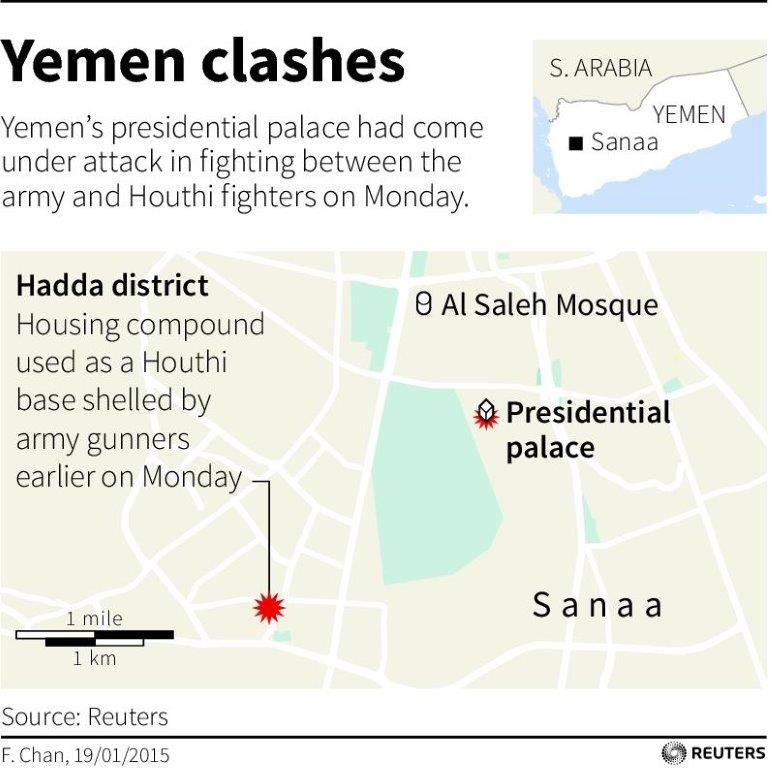American diplomats in Yemen were fired upon at a checkpoint in Sana'a, the capital city of Yemen, CNN reported Tuesday. No one was hurt.
The situation in Yemen escalated into violence this week when Houthi militiamen launched a coup against the Yemeni President Abd Rabbuh Mansur Hadi, inciting bloody clashes that killed eight people and injured scores of others on Monday alone.
The Houthis are a religious Zaidi Shia movement with an armed wing, similar to the Sadr movement in Iraq and Hezbollah in Lebanon. The country was never closer to civil war as it is now.
The Houthis have been involved in a decade-long insurgency in northern Yemen, where the population of 25 million is roughly 60 percent Sunnis and 40 percent Shiites. Both sects have ruled the country at times throughout the last 14 centuries. The Houthi’s coup is taking Yemen rapidly into a sectarian civil war that will only add to the already three civil wars in the Middle East: in Syria, Iraq and Libya — and it is giving further gains for al-Qaeda.
Related: How Yemen Is Making ISIS and al-Qaeda Even More Dangerous
The Houthi coup in Yemen creates sectarian tension mimicking situations in Iraq in 2006 and 2014 and Syria in 2011 where the Sunni population felt so threatened by dominant Shiite militias that they aligned with terrorists.
It might also encourage al-Qaeda and ISIS to work together while facing another common Shiite enemy. A recent case of cooperation between the two groups took place in Paris early this month: the two brothers who attacked Charlie Hebdo magazine were trained by al-Qaeda in Yemen and the third attacker who killed a policewoman and four hostages in a kosher market was a member of ISIS.
Al-Qaeda on the Offense Again
“Armed Houthi militants are committing a crime against humanity by launching a war against the state in Sana’a streets, inhabited with more than two million citizens,” said the Nobel Peace Prize Laureate Tawakkol Karman.
In September 2014, Houthi rebels seized control of Yemeni capital Sana’a. But while they controlled much of the state’s institutions, they tried to avoid clashing with the president. They did, however, force him to form a new government.
The current crisis started when the Houthis kidnapped the president’s chief of staff on Saturday. They wanted to halt the process of discussing the new constitution since they objected to some of its provisions. The chief of staff was a major force in promoting the new draft. Soon, the chief of staff’s influential tribe in the oil rich southern part of the country decided to stop oil production. The Houthis responded by deploying their militia near the presidential palace and controlling the TV station on Monday. The presidential guard forces fought back, and the prime minister survived an assassination attempt later on in the day.
Related: Car Bomb Kills 35 People Outside Yemen Police College
“Heavy shooting targets Prime Minister's cars after meeting with president”, said Ndia Sakkaf, Yemen’s information minister. A fragile truce that was reached on Monday didn’t last long. On Tuesday, the Houthis attacked again and controlled the presidential palace.
The Wall Street Journal reported that the militia took dozens of hostages, trained by U.S. Special Forces and seized heavy artillery and Russian-made tanks. They said Hadi, an important counterterrorism ally of the U.S., was missing. The U.S. has given Yemen nearly $1billion in military and foreign aid since 2011, The Journal reported.
Yemen has been in crisis for years. In January 2011, a revolution started as part of the Arab Spring. The country’s youth stood up against former dictator Ali Abdullah Salih, who had ruled the country since 1978. Salih stepped down in February 2012. President Hadi, his Sunni successor, held a national conference in March 2013 in an effort to unite the different factions. In January 2014, they agreed to draft a new constitution that would make Yemen a federal country with more power to the provinces, in theory inclusive of all groups and encouraging their participation.
In August 2014, the Yemeni government decided to lift its subsidies on fuel. With about half of Yemenis below the poverty line; Houthi rebels protested the decision and advanced toward the capital, Sana’a. On September 21, the Houthis captured Sana’a with little resistance from the army.
Top Reads from The Fiscal Times:




